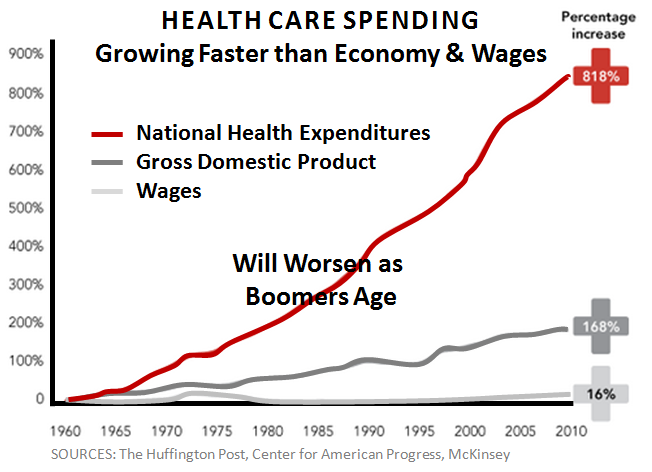Why US Health Care is Obscenely Expensive (Infographic)
US Health Care is Obscenely Expensive.
We spend more on health care
but live sicker and die younger. Why?
While we’ve published dozens of articles addressing that issue, and have accumulated thousands of statistics, today we highlight an important infographic. It combines 12 charts by Jan Diehm for The Huffington Post, addressing causes of high US healthcare costs. Afterwards is a video description and my own view of how Obamacare addresses some of the issues.
Why U.S. Health Care is Obscenely Expensive

Why American Health Care is So Expensive?
(A Video Explanation)
How Obamacare addresses the issues?
(mHealthTalk view)
Conservative healthcare arguments favor market-based solutions, as opposed to government or insurance intervention. They blame high health care costs on the lack of effective incentives to shop around for the best value. While that’s partially correct, it seems to not understand the real causes and how Obamacare addresses many of them.
Insurance — Obamacare has many provisions designed to increase competition in health care. Insurers, for example, are now prevented from denying or dropping coverage for someone with a preexisting or expensive condition, and they must spend at least 80% of their premiums on actual medical care, not administration, marketing, or profit. In exchange for the added risk of insuring sicker people, the insurance mandate now requires that everyone have insurance, providing a larger pool to share those risks. The new insurance exchanges make it easier for consumers without employer or government insurance to compare coverage plans in their state and more easily understand the difference between competing bronze, silver, gold and platinum plans.
People will still be unlikely to shop around during a heart attack, even if their insurance plan reimburses all costs with no copay. But most plans have a deductible that must be met before any benefits are paid, and they do require a copay. The trend of affordable plans is to trade-off cheaper premiums for higher deductibles & copays. That leaves consumers with plenty of incentive to shop for the best health care value, at least until their deductible is met.
Secret Charges — The next problem is that providers, especially hospitals, rarely disclose their “secret” list of charges, so even if you asked, they wouldn’t tell you what a procedure would cost ahead of time. Instead, you ended up getting a variety of different bills for weeks or months afterwards. You don’t get one itemized bill when you leave, or an estimate of that before hand. But that is changing. Part of Obamacare is to bring more transparency to those charges so consumers actually CAN shop around.
Duplication — The profit incentive of providers causes them to treat medical record information as proprietary, often in hard copy form. They make it difficult for patients to access their own data or for other providers to do so. When selecting an electronic medical records system, they often prefer proprietary software that is incompatible with other providers’ systems. That discourages patients from going to competing providers and promotes the duplication of tests that have already been done elsewhere, at added cost, of course. Obamacare hopes to address this problem by promoting electronic medical records and providing providers financial incentives to use them and actually share.
Outcomes — Obamacare penalizes hospitals when patients are readmitted too soon, suggesting that the job wasn’t done right the first time. That avoids the common practice of charging patients for all of the work to repair problems missed (or caused) the first time. The law now also requires that hospitals survey patients as they’re discharged, and their satisfaction ratings will be added to the newly disclosed list of charges for common procedures. This will only improve over time.
Best Cost Explanation — My favorite explanation of Why Health Care Costs Are So Obscenely High is still Steven Brill’s 38-page special report for TIME Magazine. Unfortunately, it’s now behind a pay-wall, so I’ve posted a summary that includes a video interview with Brill himself. Check it out.
Best Obamacare Summary — Also check out our page on Understanding Obamacare and this related article with perspectives of Dr. James Rohack, president of the American Medical Association during debates over Obama’s Healthcare Law.

